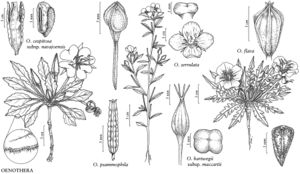Oenothera flava
Spring Fl. Wasatch ed. 4, 106. 1927.
Herbs perennial, rarely short-lived, acaulescent or very short-caulescent, glabrate to moderately strigillose, usually also glandular puberulent, sometimes sparsely hirsute distally; from a taproot. Stems (when present) ascending, 1–several, usually densely leafy, 0–2 cm. Leaves primarily in a basal rosette, (3.4–) 6–30 (–36) × (0.5–) 1.5–5 (–7) cm, flexible, sometimes ± fleshy; petiole (0.2–) 2–7 (–10) cm; blade oblanceolate to linear, margins usually irregularly and coarsely pinnately lobed, rarely subentire, apex acute. Flowers 1–4 opening per day near sunset; buds with free tips (1–) 2–10 (–12) mm; floral-tube (24–) 40–200 (–265) mm; sepals (8–) 11–40 (–42) mm; petals bright-yellow, sometimes paler (in smaller-flowered plants), fading pale orange, drying purple, (7–) 10–45 (–50) mm; filaments (5–) 8–23 (–26) mm, anthers (2–) 3–13 (–16) mm; style (40–) 50–250 (–290) mm, stigma exserted beyond or surrounded by ring of anthers. Capsules leathery in age, surface usually conspicuously reticulate, usually narrowly ovoid or ellipsoid, sometimes ovoid or lanceoloid, winged, wings narrowly oblong, (2–) 3–5 (–6) mm wide, confined to distal 2/3 of capsule, (10–) 20–35 (–43) × 4–8 mm (excluding wings), gradually constricted to a short beak, dehiscent 1/4–1/2 their length, valve surface usually conspicuously reticulate; sessile. Seeds asymmetrically cuneiform, 1.8–2.2 (–2.6) mm. 2n = 14.
Phenology: Flowering Mar–Aug(–Oct).
Habitat: Local and colonial, sometimes abundant in wet (at least seasonally moist) clay to gravelly sand of swales, desiccating flats and ponds, montane meadows, margins of permanent or seasonal watercourses, open sites.
Elevation: 300–3200 m.
Distribution
Alta., Man., Sask., Ariz., Calif., Colo., Idaho, Mont., Nebr., Nev., N.Mex., N.Dak., Oreg., S.Dak., Utah, Wash., Wyo., Mexico (Chihuahua), Mexico (Durango), Mexico (Guanajuato), Mexico (Hidalgo), Mexico (Jalisco), Mexico (Sonora)
Discussion
Petals in Oenothera flava typically range from 7–32 mm with floral tubes 24–100 mm; however, plants from three disjunct areas: the Mogollon Plateau in Arizona to Catron County, New Mexico; Sacramento Mountains and Sierra Blanca, Lincoln and Otero counties, New Mexico; and the Sierra Madre Occidental from northern Chihuahua south to Durango, have much larger petals (30–55 mm) and longer floral tubes (80–265 mm). They were originally recognized as a distinct species or most recently as a subspecies (O. flava subsp. taraxacoides), but detailed study of the variation pattern suggests that the larger flowers occur in areas of high hawkmoth species diversity and higher rates of outcrossing, similar to the pattern discussed in detail by D. P. Gregory (1963, 1964). R. A. Raguso et al. (2007) and H. E. Summers et al. (2015) came to the same conclusion in an independent study of floral biology of sect. Lavauxia. Because populations from the three disjunct areas appear to have diverged independently from lower-elevation source populations, it seems best to treat the complex as one variable species without any formal subdivision.
Selected References
None.
Lower Taxa
"/4" is not declared as a valid unit of measurement for this property.
